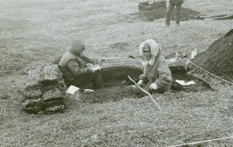Ipiutak Site facts for kids
|
Ipiutak Site
|
|

Excavating the Ipiutak site
|
|
| Location | Address restricted |
|---|---|
| Nearest city | Point Hope, Alaska |
| NRHP reference No. | 66000157 |
Quick facts for kids Significant dates |
|
| Added to NRHP | October 15, 1966 |
| Designated NHL | January 20, 1961 |
The Ipiutak Site is a very important archaeological site located near Point Hope in northwest Alaska, United States. It's considered one of the most significant ancient discoveries in this part of the world.
This site gives its name to the Ipiutak culture. This ancient culture began around 100–200 BCE and ended around 800 CE. The Ipiutak people lived in a wide area, from south of the Bering Strait all the way to Point Barrow.
Contents
Discovering the Ipiutak Site
The Ipiutak site was found in 1939 by archaeologists Helge Larsen and Froelich Rainey. They later wrote a detailed book about their findings in 1948.
The site has almost 600 old house foundations. These are found along four beach ridges. At first, people thought these lines of houses were planned roads or "avenues." However, many houses are too close together to have been used at the same time.
Scientists used radiocarbon dating to find out when the houses were built. This showed that it took 300 to 400 years to build all the houses. Archaeologists now believe that only about 125 to 200 people lived at the site at any one time. This means only 20 to 30 houses were used in each generation. Earlier ideas that over 4,000 people lived there were incorrect.
What Was Found at Ipiutak?
During digs in 1940 and 1941, many items were found. These came from 74 square houses built from driftwood. Over 120 ancient burials were also uncovered. These important collections are now kept in three museums. They are at the National Museum of Denmark, the American Museum of Natural History, and the University of Alaska Fairbanks.
Amazing Art and Burials
The Ipiutak site is famous for the special objects found in its burials. One of these is called a "mask." It looks like a human face with a wide-open mouth. It also shows blowfly larvae coming out of the nose. This mask likely had a deep meaning related to shamanistic beliefs. A similar object was found in Deering, dating back to 600 to 800 CE.
Many beautiful carvings made from ivory were also discovered. These carvings were made using iron tools called burins. They show animals like polar bears, loons, and seals. Sometimes, they even show human figures.
Daily Life and Tools
The houses at Ipiutak show signs of special skills. People were good at working with walrus tusks. Some graves also show signs of fighting, suggesting there might have been warfare.
Two key features of the Ipiutak culture are their tools and their pottery. They made very fine stone tools, especially for arrow points. However, they did not use pottery.
The Ipiutak culture is known for its unique art style. It uses lines, circles, and dots. This style is very similar to the Old Bering Sea culture. That culture lived only around the Bering Strait and nearby Siberia. The Ipiutak culture existed at the same time as the later parts of the Old Bering Sea culture. They likely had strong connections in trade and society.
Some early researchers thought Ipiutak art was linked to ancient cultures in the Ukraine. But there is little evidence to support this idea. Instead, Ipiutak culture is more like the widespread Norton culture in Alaska. The Norton culture, however, did use pottery and fished for salmon.
The Ipiutak people mainly hunted sea mammals for food. Ringed seals and walrus were very important. They also hunted caribou.
Ipiutak's Importance Today
The Ipiutak site was named a National Historic Landmark in 1961. It was then added to the National Register of Historical Places in 1966. This means it is a very important place in American history.
Other sites have also been linked to the Ipiutak culture. These include places like Cape Krusenstern, Itivlik Lake, and Anaktuvuk Pass, Alaska. The art from the Ipiutak culture is very detailed. It is thought to be an early form of Inuit art. It is still a mystery why the Ipiutak people did not hunt whales or make pottery. This is surprising because they lived in well-developed settlements.

